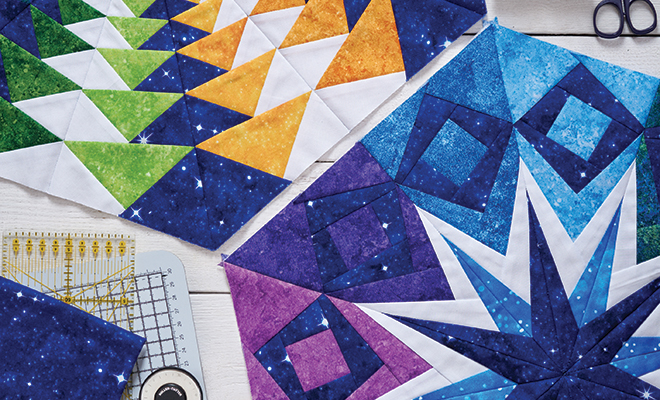
EPP: Life in the Slow Lane
…surely helps you soothe your mind! My apologies to Joe Walsh, Glenn Frey and Don Henley, the Eagles and “Hotel California.” I’m sure English paper piecing was not part of the backstory for the song.
Alittle over a year ago, I was talking with Tammy McDonald, HERLIFE Magazine’s driving force, about her recovery from COVID and its symptoms, including the inability to sleep. “One of the activities that got me through those long, sleepless nights was sewing!” she said. “I started working on a quilt using English paper piecing through a shop that does block of the month programs. In 12 to 18 months, you have a finished quilt top.”
I was intrigued. I’ve been sewing, crocheting, knitting and anything to keep my hands busy since I was five, but the intricacy and art of quilting seemed beyond my grasp. Well, why not? Let’s just jump in with the first block of the month. Then a second pattern caught my eye. Signed up for that one; now I’m really in deep.
History
English paper piecing is a hand sewing technique that involves stitching or gluing fabric shapes around a paper template and then hand-sewing the shapes together to make blocks. Once you have finished all the blocks and sewn them together, the paper templates are removed before the quilt top, batting and backing are put together, basted and finished. The templates can be saved and reused for another project.
It’s a centuries-old quilting technique; the earliest hexagon template researchers have found was made in England in 1770. The earliest known hexagon quilt in the United States can be dated back to 1807. Paper was a luxury in the 1800s, and women often reused newspaper, letters, catalogs and other paper sources as foundation piecing. The paper was frequently left in the quilts, providing an extra layer of insulation and a glimpse into the day-to-day life of the period. In the 1920s and 1930s, the technique found popularity in the United States since small pieces of fabric, often scraps, could be used and were affordable during the Great Depression.
The Essentials
Helpful tools to begin any quilting project are a rotating cutting mat, rotary cutters and replacement blades, good fabric scissors, paper scissors, very sharp needles, hand quilting thread to blend with the fabrics you choose and, particularly for EPP, fabric glue. The choice of glue is crucial; I started with glue in a bottle on the first block and realized it was too much glue! Sticks are preferable. Add sharp eyes and steady hands to get started.
If you don’t want to glue the fabric or if it’s not suitable for glue, the fabric can be basted with needle and thread around the template. The preponderance of quilt patterns call for a one-quarter-inch seam allowance. With a block of the month, abbreviated BOM, the fabric quantities provided generally allow the sewer to cut with a larger seam allowance, which I have found is very helpful and prevents fabric fraying.
The Help
Google it! Innumerable websites and YouTube videos give step-by-step instructions. The designers of BOM quilts frequently post a month-by-month tutorial to support the novices and experienced sewists.
EPP is a portable craft, too, which increases its appeal. A travel kit can be as simple as slider bags or as beautiful and organized as a purchased or handmade kit. Red-Handled Scissors offers a free pattern (for personal use only) to create a case that’s a 6” x 6” square, about 3” thick, the perfect size to toss into a purse, tote or project bag.
Crafters have divergent opinions of EPP and quilting. A family child asked what I was doing with my papers, fabrics and needles, and when I explained, a family parent (who needlepoints!) said, “It’s really tedious.” My friend Dot, a lifelong sewist, said about a project for a charity bazaar, “I received a finished quilt top to refashion into items for the bazaar, and it still had the paper pieces in it! We made table runners and pillows that sold fast!”
Odds are there’s a quilter’s guild or a fabric shop in your town and people who are passionate about quilting to help you on the path to creating your family heirloom. Get started, one block at a time!
Sources: thesewingdirectory.co.uk, redhandledscissors.com, aquiltinglife.com, faithandfabricdesign.com, jaybirdquilts.com and pinkdoorfabrics.com.
Tips for Easy EPP
• First, give yourself some grace. Templates aren’t always perfect and you’ll need to make miniscule adjustments on pieces.
• Pack your patience. This goes with grace.
• It helps to have a dedicated sewing space where you can leave your mess and clean up later.
• Don’t use too much glue!
• Make sure the paper templates are accurate for the pattern you’re using. Paper templates can be ordered online, but one pattern’s one-inch triangle may not be the exact size you need.







